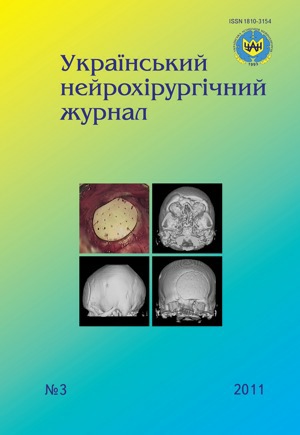Exclusion of giant aneurysm of cavernous part of internal carotid artery by intracranial implantation of stream-directive stent Silk
DOI:
https://doi.org/10.25305/unj.57800Keywords:
giant arterial aneurysm, stream-directive stent Silk, endovascular treatmentAbstract
The case of endovascular surgical treatment of giant aneurysm of cavernous part of internal carotid artery by stream-directive stent Silk implantation as an example of new advanced technology for brain giant aneurysms’ treatment is given. The results of control investigation 3 months after operation showed high efficacy of applied endovascular technology and satisfactory result of surgical treatment. This method requires further research.
References
Follow-up angiography of intracranial aneurysms treated with endovascular placement of Guglielmi detachable coils / J. Thornton, G.M. Debrun, V.A. Aletich [et al.] // Neurosurgery. — 2002. — V.50. — P.239–249.
Retreatment of ruptured cerebral aneurysms in patients randomized by coiling or clipping in the International Subarachnoid Aneurysm Trial (ISAT) / A. Campi, N. Ramzi, A.J. Molyneux [et al.] // Stroke. — 2007. — V. 38. — P.1538–1544.
Long-term follow-up of cerebral aneurysms after endovascular therapy prediction and outcome of retreatment / T. Ries, S. Siemonsen, G. Thomalla [et al.] // Am. J. Neuroradiol. — 2007. — V.28. — P.1755–1761.
Intravascular stent and endovascular coil placement for a ruptured fusiform aneurysm of the basilar artery. Case report and review of the literature / R.T. Higashida, W. Smith, D. Gress [et al.] // J. Neurosurg. — 1997. — V.87. — P.944–949.
Endovascular reconstruction of intracranial arteries by stent placement and combined techniques / P. Lylyk, J. E. Cohen, R. Ceratto [et al.] // J. Neurosurg. — 2002. — V.97. — P.1306–1313.
Early experience in the treatment of intra–cranial aneurysms by endovascular flow diversion : a multicentre prospective study / J. V. Byrne, R. Beltechi, J. A. Yarnold [et al.] // PLoS One. — 2010. — V.5, N9. — P.12492.
An in vitro study of silk stent morphology / T. Aurboonyawat, R. Blanc, P. Schmidt [et al.] // Am. J. Neuroradiol. — 2010. — V.31, N.3. — P.494–495.
Flow-diverter stent for the endovascular treatment of intracranial aneurysms: a prospective study in 29 patients with 34 aneurysms / B. Lubicz, L. Collignon, G. Raphaeli [et al.] // Stroke. — 2010. — V.41, N10. — P.2247–2253.
Effect of flow diversion treatment on very small ruptured aneurysms / Z. Kulcsr, S.G. Wetzel, L. Augsburger [et al.] // Neurosurgery. — 2010. — V.67, N3. — P.789–793.
High–profile flow diverter (silk) implantation in the basilar artery: Efficacy in the treatment of aneurysms and the role of the perforators / Z. Kulcsr, U. Ernemann, S.G. Wetzel [et al.] // Stroke. — 2010. — V.41, N8. — P.1690–1696.
The effect of stents on intra-aneurysmal hemodynamics: in vitro evaluation of a pulsatile sidewall aneurysm using laser Doppler anemometry / F. Dorn, F. Niedermeyer, A. Balasso [et al.] // Neuroradiology. — 2011. — V.53, N4. — P. 267–272.
Infectious aneurysm of the cavernous carotid artery in a child treated with a new–generation of flow-diverting stent graft : case report / G. Appelboom, K. Kadri, F. Hassan, X. Leclerc // Neurosurgery. — 2010. — V.66, N3. — P.623–624.
Treatment of carotid siphon aneurysms with a microcell stent. A case report / M. Leonardi, M. Dall’olio, C. Princiotta, L. Simonetti // Int. Neuroradiol. — 2008. — V.14, N4. — P.429–434.
Early fatal hemorrhage after endovascular cerebral aneurysm treatment with a flow diverter (SILK–Stent): do we need to rethink our concepts? / B. Turowski, S. Macht, Z. Kulcsr [et al.] // Neuroradiology. — 2011. — V.53, N1. — P.37–41.
Downloads
Published
How to Cite
Issue
Section
License
Copyright (c) 2011 Volodymyr Moroz, Orest Tsimeyko, Ihor Skorokhoda, Marina Globa, Y. Ternitskaya

This work is licensed under a Creative Commons Attribution 4.0 International License.
Ukrainian Neurosurgical Journal abides by the CREATIVE COMMONS copyright rights and permissions for open access journals.
Authors, who are published in this Journal, agree to the following conditions:
1. The authors reserve the right to authorship of the work and pass the first publication right of this work to the Journal under the terms of Creative Commons Attribution License, which allows others to freely distribute the published research with the obligatory reference to the authors of the original work and the first publication of the work in this Journal.
2. The authors have the right to conclude separate supplement agreements that relate to non-exclusive work distribution in the form of which it has been published by the Journal (for example, to upload the work to the online storage of the Journal or publish it as part of a monograph), provided that the reference to the first publication of the work in this Journal is included.









